Publications
Peer-reviewed papers
2021-
[47] "Influence of varying the nickel salt aqueous subphase on the formation of Ni3(hexaiminotriphenylene)2 metal–organic framework nanosheets at the air/liquid interface"Kazuaki Tachimoto, Kanokwan Jumtee Takeno, Rie Makiura*
CrystEngComm, 27, 5793-5802 (2025).
https://doi.org/10.1039/D5CE00630A
Published : 21 Aug. 2025
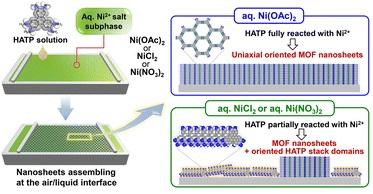 Metal–organic framework (MOF) nanosheets synthesized at the air/liquid interface exhibit properties, such as electrical conductivity, that are highly dependent on their structural attributes, including morphology, lateral dimensions, thickness, crystallinity, and orientation. Achieving precise control over these features, however, remains a significant challenge. Extending our previous works on the air/liquid interfacial synthesis of uniaxially oriented Ni3(HITP)2 nanosheets (HITP-Ni-NS), this study explores the profound influence of the metal salt counterion—a key parameter in MOF crystallization. We present a systematic investigation into how nickel acetate (Ni(OAc)2), nickel chloride (NiCl2), and nickel nitrate (Ni(NO3)2) precursors affect the resulting nanosheet morphology, thickness, crystallinity, and orientation. Our comparative interfacial syntheses demonstrate that variations in the counterion significantly impact crystal growth kinetics, leading to discernible differences in nanosheet architecture. Notably, while NiCl2 and Ni(NO3)2 precursors result in the incorporation of unreacted HATP ligand stacks and subsequent nanosheet disorder, Ni(OAc)2 consistently produces HITP-Ni-NS with the greatest thickness and maintains perfect alignment with a preferred ordered crystalline stacking orientation. These observed differences are attributed to variations in the HITP-Ni-NS crystal growth mechanism, likely mediated by the distinct pH of the nickel aqueous subphases. These findings highlight the critical role of the metal salt counterion in directing the growth and ultimately tailoring the functional properties of MOF nanosheets.
Metal–organic framework (MOF) nanosheets synthesized at the air/liquid interface exhibit properties, such as electrical conductivity, that are highly dependent on their structural attributes, including morphology, lateral dimensions, thickness, crystallinity, and orientation. Achieving precise control over these features, however, remains a significant challenge. Extending our previous works on the air/liquid interfacial synthesis of uniaxially oriented Ni3(HITP)2 nanosheets (HITP-Ni-NS), this study explores the profound influence of the metal salt counterion—a key parameter in MOF crystallization. We present a systematic investigation into how nickel acetate (Ni(OAc)2), nickel chloride (NiCl2), and nickel nitrate (Ni(NO3)2) precursors affect the resulting nanosheet morphology, thickness, crystallinity, and orientation. Our comparative interfacial syntheses demonstrate that variations in the counterion significantly impact crystal growth kinetics, leading to discernible differences in nanosheet architecture. Notably, while NiCl2 and Ni(NO3)2 precursors result in the incorporation of unreacted HATP ligand stacks and subsequent nanosheet disorder, Ni(OAc)2 consistently produces HITP-Ni-NS with the greatest thickness and maintains perfect alignment with a preferred ordered crystalline stacking orientation. These observed differences are attributed to variations in the HITP-Ni-NS crystal growth mechanism, likely mediated by the distinct pH of the nickel aqueous subphases. These findings highlight the critical role of the metal salt counterion in directing the growth and ultimately tailoring the functional properties of MOF nanosheets.
Tomoko Fujino*, Mafumi Hishida*, Masatoshi Ito, Toshikazu Nakamura, Mizue Asada, Naoya Kurahashi, Hisao Kiuchi, Yoshihisa Harada, Koji Harano, Rie Makiura, Kanokwan Jumtee Takeno, So Yokomori, Hiroshi Oike, Hatsumi Mori
Advanced Science, 12, 29, 2504967 (2025). Open Access
https://doi.org/10.1002/advs.202504967
Published : 23 April 2025
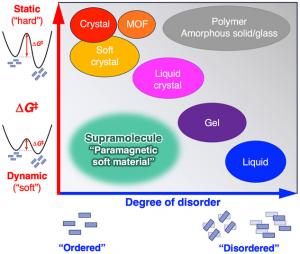 Meeting the Internet of Things (IoT) demand for flexible organic spintronics requires dynamically flexible, “soft” organic magnetic materials. These materials should be capable of reordering their macroscopic assemblies in response to external stimuli. Unlike conventional rigid, “hard” crystalline organic paramagnets, that are typically composed of open-shell π- or d/π-conjugated planar molecules and rely on intermolecular interactions in the ordered, assembled structures, soft paramagnets necessitate a delicate balance between long-range structural order (essential for controlling magnetic properties) and dynamic flexibility a challenge previously unmet for open-shell planar molecules. In this study, an amphiphilic d/π-conjugated nickel dithiolate radical anion salt is presented that self-assembles into ordered membranes, forming capsule-like macrostructures with exceptional stability in aqueous environments. This design achieves the desired balance. These assemblies exhibit uniaxial magnetic anisotropy driven by significant spin–spin interactions and undergo temperature-dependent macroscopic structural transitions representing, to the knowledge, the first observation of such behavior for assemblies of open-shell planar molecules. This well-defined, single-molecular-weight system provides critical structural and mechanism insights for soft matter design and a versatile platform for spintronic applications. The findings advance the development of flexible, tunable molecular soft paramagnets, expanding their potential for innovative applications in flexible devices and beyond.
Meeting the Internet of Things (IoT) demand for flexible organic spintronics requires dynamically flexible, “soft” organic magnetic materials. These materials should be capable of reordering their macroscopic assemblies in response to external stimuli. Unlike conventional rigid, “hard” crystalline organic paramagnets, that are typically composed of open-shell π- or d/π-conjugated planar molecules and rely on intermolecular interactions in the ordered, assembled structures, soft paramagnets necessitate a delicate balance between long-range structural order (essential for controlling magnetic properties) and dynamic flexibility a challenge previously unmet for open-shell planar molecules. In this study, an amphiphilic d/π-conjugated nickel dithiolate radical anion salt is presented that self-assembles into ordered membranes, forming capsule-like macrostructures with exceptional stability in aqueous environments. This design achieves the desired balance. These assemblies exhibit uniaxial magnetic anisotropy driven by significant spin–spin interactions and undergo temperature-dependent macroscopic structural transitions representing, to the knowledge, the first observation of such behavior for assemblies of open-shell planar molecules. This well-defined, single-molecular-weight system provides critical structural and mechanism insights for soft matter design and a versatile platform for spintronic applications. The findings advance the development of flexible, tunable molecular soft paramagnets, expanding their potential for innovative applications in flexible devices and beyond.
Takeshi Watanabe*, Takashi Ohata, Rie Makiura, and Ichiro Hirosawa
JPS Conference Proceedings, 41, 011009 (2024).
https://doi.org/10.7566/JPSCP.41.011009
Published : 1 March 2024 [44] "Self-Assembly of Peptide-Conjugated Forklike Mesogens at Aqueous/Liquid Crystalline Interfaces: Molecular Design for Ordering Transition Induced by Specific Binding of Biomolecules"
Junya Uchida*, Anna Niwa, Mina Hasome, Rie Makiura, Nicholas L. Abbott and Takashi Kato*
ACS Applied Materials & Interfaces, 15, 30, 36657-3666 (2023).
https://doi.org/10.1021/acsami.3c04289
Published : 21 July 2023
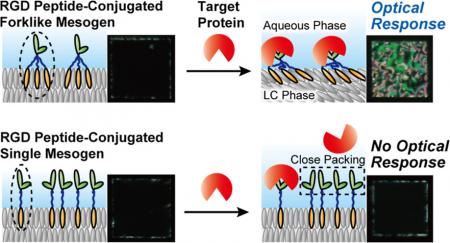 Self-assembly of functional liquid crystals provides a powerful approach to the development of stimuli-responsive materials and interfaces. Here, we have designed and synthesized bioconjugated amphiphilic dendritic mesogens containing arginine–glycine–aspartic acid (RGD) peptide sequence to develop new biofunctional aqueous/liquid crystalline interfaces. We have found that the RGD peptide-conjugated forklike mesogens induce the homeotropic alignment of liquid crystals at the aqueous interfaces, leading to distinct optical changes caused by the specific binding of the target proteins. In contrast, no response to the target protein is observed for the interfaces prepared with the RGD peptide-conjugated single mesogen. Molecular insights into the orientation and stimuli-responsiveness of the bioconjugated mesogens at the interfaces are obtained based on measurements of the Langmuir films and self-assembled properties of these molecules. These results demonstrate that the number of rodlike cores of the bioconjugated mesogens affects the monolayer structures formed at the aqueous interface as well as the liquid crystalline properties. We propose a new molecular design of bioconjugated mesogens to couple biomolecular interactions at the aqueous interfaces with the ordering transition of the liquid crystals. These materials have the potential to tailor the responsiveness of liquid crystalline interfaces for biomolecular sensing.
Self-assembly of functional liquid crystals provides a powerful approach to the development of stimuli-responsive materials and interfaces. Here, we have designed and synthesized bioconjugated amphiphilic dendritic mesogens containing arginine–glycine–aspartic acid (RGD) peptide sequence to develop new biofunctional aqueous/liquid crystalline interfaces. We have found that the RGD peptide-conjugated forklike mesogens induce the homeotropic alignment of liquid crystals at the aqueous interfaces, leading to distinct optical changes caused by the specific binding of the target proteins. In contrast, no response to the target protein is observed for the interfaces prepared with the RGD peptide-conjugated single mesogen. Molecular insights into the orientation and stimuli-responsiveness of the bioconjugated mesogens at the interfaces are obtained based on measurements of the Langmuir films and self-assembled properties of these molecules. These results demonstrate that the number of rodlike cores of the bioconjugated mesogens affects the monolayer structures formed at the aqueous interface as well as the liquid crystalline properties. We propose a new molecular design of bioconjugated mesogens to couple biomolecular interactions at the aqueous interfaces with the ordering transition of the liquid crystals. These materials have the potential to tailor the responsiveness of liquid crystalline interfaces for biomolecular sensing.
Kazuaki Tachimoto, Takashi Ohata, Kanokwan Jumtee Takeno, Akihiro Nomoto, Takeshi Watanabe, Ichiro Hirosawa, and Rie Makiura*
Langmuir, 39, 8952-8962 (2023).
https://doi.org/10.1021/acs.langmuir.2c02685
Published: 16 June 2023
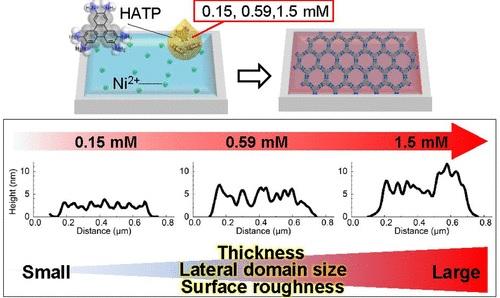 Metal–organic frameworks (MOFs)─crystalline coordination polymers─with unique characteristics such as structural designability accompanied by tunable electronic properties and intrinsic uniform nanopores have become the platform for applications in diverse scientific areas ranging from nanotechnology to energy/environmental sciences. To utilize the superior features of MOF in potential applications, the fabrication and integration of thin films are of importance and have been actively sought. Especially, downsized MOFs into nanosheets can act as ultimately thin functional components in nanodevices and potentially display unique chemical/physical properties rarely seen in bulk MOFs. Assembling nanosheets by aligning amphiphilic molecules at the air/liquid interface has been known as the Langmuir technique. By utilizing the air/liquid interface as a reaction field between metal ions and organic ligands, MOFs are readily formed into the nanosheet state. The expected features in MOF nanosheets including electrical conduction largely depend on the nanosheet characteristics such as lateral size, thickness, morphology, crystallinity, and orientation. However, their control has not been achieved as yet. Here, we demonstrate how changing the concentration of a ligand spread solution can modify the assembly of MOF nanosheets, composed of 2,3,6,7,10,11-hexaiminotriphenylene (HITP) and Ni2+ ions (HITP-Ni-NS), at the air/liquid interface. A systematic increase in the concentration of the ligand spread solution leads to the enlargement of both the lateral size and the thickness of the nanosheets while retaining their perfect alignment and preferred orientation. On the other hand, at much higher concentrations, we find that unreacted ligand molecules are included in HITP-Ni-NS, introducing disorder in HITP-Ni-NS. These findings can develop further sophisticated control of MOF nanosheet features, accelerating fundamental and applied studies on MOFs.
Metal–organic frameworks (MOFs)─crystalline coordination polymers─with unique characteristics such as structural designability accompanied by tunable electronic properties and intrinsic uniform nanopores have become the platform for applications in diverse scientific areas ranging from nanotechnology to energy/environmental sciences. To utilize the superior features of MOF in potential applications, the fabrication and integration of thin films are of importance and have been actively sought. Especially, downsized MOFs into nanosheets can act as ultimately thin functional components in nanodevices and potentially display unique chemical/physical properties rarely seen in bulk MOFs. Assembling nanosheets by aligning amphiphilic molecules at the air/liquid interface has been known as the Langmuir technique. By utilizing the air/liquid interface as a reaction field between metal ions and organic ligands, MOFs are readily formed into the nanosheet state. The expected features in MOF nanosheets including electrical conduction largely depend on the nanosheet characteristics such as lateral size, thickness, morphology, crystallinity, and orientation. However, their control has not been achieved as yet. Here, we demonstrate how changing the concentration of a ligand spread solution can modify the assembly of MOF nanosheets, composed of 2,3,6,7,10,11-hexaiminotriphenylene (HITP) and Ni2+ ions (HITP-Ni-NS), at the air/liquid interface. A systematic increase in the concentration of the ligand spread solution leads to the enlargement of both the lateral size and the thickness of the nanosheets while retaining their perfect alignment and preferred orientation. On the other hand, at much higher concentrations, we find that unreacted ligand molecules are included in HITP-Ni-NS, introducing disorder in HITP-Ni-NS. These findings can develop further sophisticated control of MOF nanosheet features, accelerating fundamental and applied studies on MOFs.
Shintaro Toda, Kanokwan Jumtee Takeno, and Rie Makiura*
Journal of Physics and Chemistry of Solids, 181, 111512 (2023).
https://doi.org/10.1016/j.jpcs.2023.111512
Published: 16 June 2023
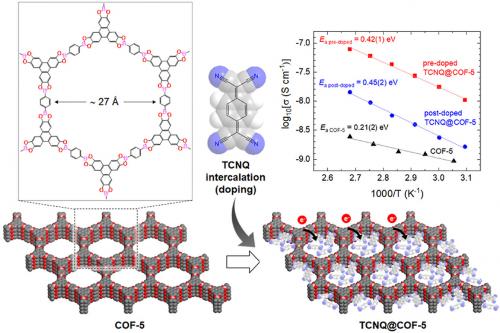 Covalent organic frameworks (COFs) are crystalline organic materials with high porosity. The COFs are typically electrical insulators because of their wide bandgaps and closed-shell structures despite their π–π layer stacking motif suitable for carrier conduction. Here, we report a strategy for realizing tunable electrical conductivity in COFs by intercalating redox-active guest molecules. The approach is demonstrated using COF-5 with a boronate-ester-linked two-dimensional structure and one-dimensional nanopore channels infiltrated by 7,7,8,8-tetracyanoquinododimethane (TCNQ). Successful incorporation of guest TCNQ molecules into the cavities of the COF-5 host is confirmed by vibrational and optical spectroscopies and results in the appearance of guest–host charge-transfer transitions for TCNQ-intercalated COF-5. Overall electrical conductivities are enhanced by the carrier generation induced by the charge transfer between TCNQ and COF-5 with the retained layer-stacked structures in COF-5 also contributing to the conduction pathways. The tunable electronic properties of COFs realized by the host–guest strategies established here will further promote refinement of design principles of conductive COFs and deeper understanding of the conduction mechanism while simultaneously providing opportunities for using COFs in diverse applications.
Covalent organic frameworks (COFs) are crystalline organic materials with high porosity. The COFs are typically electrical insulators because of their wide bandgaps and closed-shell structures despite their π–π layer stacking motif suitable for carrier conduction. Here, we report a strategy for realizing tunable electrical conductivity in COFs by intercalating redox-active guest molecules. The approach is demonstrated using COF-5 with a boronate-ester-linked two-dimensional structure and one-dimensional nanopore channels infiltrated by 7,7,8,8-tetracyanoquinododimethane (TCNQ). Successful incorporation of guest TCNQ molecules into the cavities of the COF-5 host is confirmed by vibrational and optical spectroscopies and results in the appearance of guest–host charge-transfer transitions for TCNQ-intercalated COF-5. Overall electrical conductivities are enhanced by the carrier generation induced by the charge transfer between TCNQ and COF-5 with the retained layer-stacked structures in COF-5 also contributing to the conduction pathways. The tunable electronic properties of COFs realized by the host–guest strategies established here will further promote refinement of design principles of conductive COFs and deeper understanding of the conduction mechanism while simultaneously providing opportunities for using COFs in diverse applications.
Takashi Ohata, Akihiro Nomoto, Takeshi Watanabe, Ichiro Hirosawa, Tatsuyuki Makita, Jun Takeya, and Rie Makiura*
Journal of Colloid and Interface Science, in press.
https://doi.org/10.1016/j.jcis.2023.05.151
Available online : 26 May 2023
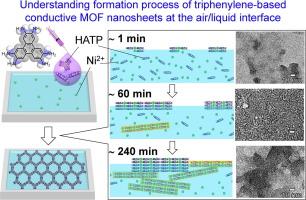 The air/liquid interface is a superior platform to create nanosheets of materials by promoting spontaneous two-dimensional growth of components. Metal–organic frameworks (MOFs)—intrinsically porous crystals—with π-conjugated triphenylene-based ligands show high electrical conductivities. Forming nanosheets of such conductive MOFs should enable their use in electronic devices. Although highly conductive MOF nanosheets have been created at the air/liquid interface, direct control of their continuity, morphology, thickness, crystallinity, and orientation directly influencing device performance remains as an issue to be addressed. Here, we present detailed insights into the formation process of electrically conductive MOF nanosheets composed of 2,3,6,7,10,11-hexaiminotriphenylene (HITP) and Ni2+ ions (HITP-Ni-NS) at the air/liquid interface. The morphological and structural features of HITP-Ni-NS strongly depend on the standing time—the time without any external actions involved, but leaving the interface undisturbed after setting the ligand solution onto the metal-ion solution. We find that the fundamental features of HITP-Ni-NS are determined by the standing time with conductivity sensitively influenced by such pre-determined HITP-Ni-NS characteristics. These findings will lead towards the establishment of a rational strategy for creating MOF nanosheets at the air/liquid interface with desired properties, thereby accelerating their use in diverse potential applications.
The air/liquid interface is a superior platform to create nanosheets of materials by promoting spontaneous two-dimensional growth of components. Metal–organic frameworks (MOFs)—intrinsically porous crystals—with π-conjugated triphenylene-based ligands show high electrical conductivities. Forming nanosheets of such conductive MOFs should enable their use in electronic devices. Although highly conductive MOF nanosheets have been created at the air/liquid interface, direct control of their continuity, morphology, thickness, crystallinity, and orientation directly influencing device performance remains as an issue to be addressed. Here, we present detailed insights into the formation process of electrically conductive MOF nanosheets composed of 2,3,6,7,10,11-hexaiminotriphenylene (HITP) and Ni2+ ions (HITP-Ni-NS) at the air/liquid interface. The morphological and structural features of HITP-Ni-NS strongly depend on the standing time—the time without any external actions involved, but leaving the interface undisturbed after setting the ligand solution onto the metal-ion solution. We find that the fundamental features of HITP-Ni-NS are determined by the standing time with conductivity sensitively influenced by such pre-determined HITP-Ni-NS characteristics. These findings will lead towards the establishment of a rational strategy for creating MOF nanosheets at the air/liquid interface with desired properties, thereby accelerating their use in diverse potential applications.
Takashi Ohata, Kazuaki Tachimoto, Kanokwan Jumtee Takeno, Akihiro Nomoto, Takeshi Watanabe, Ichiro Hirosawa, Rie Makiura*
Bulletin of the Chemical Society of Japan, 96, 3, 274-282 (2023).
https://doi.org/10.1246/bcsj.20220283
Published: 11 March 2023
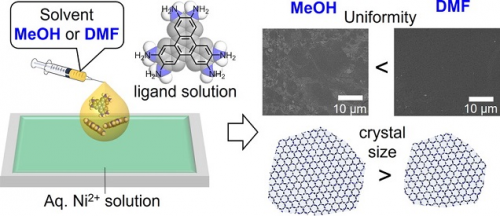 Nanosheets of metal–organic frameworks (MOFs)—porous crystalline materials consisting of metal ions and organic ligands—are actively studied for their intrinsic chemical/physical properties attributed to the reduced dimensionality and for their potential to function as ideal components of nanodevices, especially when electrical conduction is present. Air/liquid interfacial synthesis is a promising technique to obtain highly oriented MOF nanosheets. However, rational control of size and shape combined with the aimed functionality remains an important issue to address making it necessary to research the critical factors governing nanosheet characteristics in the interfacial synthesis. Here, we investigate the influence of the solvent—methanol (MeOH) versus N,N-dimethylformamide (DMF)—used to prepare a ligand spread solution on an assembly of MOF nanosheets composed of Ni2+ and 2,3,6,7,10,11-hexaiminotriphenylene (HITP) (HITP-Ni-NS). We find that the macroscopic morphological uniformity in the micrometer scale is higher when DMF is used as the solvent. Regarding the microscopic crystalline domain, molecules of DMF with relatively high polarity and boiling point are involved in HITP-Ni-NS formation, hindering its growth and resulting in nanosheets with slightly smaller lateral size than that grown when MeOH is used. These findings provide crucial guidelines towards establishing a judicious strategy for creating desired MOF nanosheets at the air/liquid interface, thereby driving forward research on both fundamental and applied aspects of this field.
Nanosheets of metal–organic frameworks (MOFs)—porous crystalline materials consisting of metal ions and organic ligands—are actively studied for their intrinsic chemical/physical properties attributed to the reduced dimensionality and for their potential to function as ideal components of nanodevices, especially when electrical conduction is present. Air/liquid interfacial synthesis is a promising technique to obtain highly oriented MOF nanosheets. However, rational control of size and shape combined with the aimed functionality remains an important issue to address making it necessary to research the critical factors governing nanosheet characteristics in the interfacial synthesis. Here, we investigate the influence of the solvent—methanol (MeOH) versus N,N-dimethylformamide (DMF)—used to prepare a ligand spread solution on an assembly of MOF nanosheets composed of Ni2+ and 2,3,6,7,10,11-hexaiminotriphenylene (HITP) (HITP-Ni-NS). We find that the macroscopic morphological uniformity in the micrometer scale is higher when DMF is used as the solvent. Regarding the microscopic crystalline domain, molecules of DMF with relatively high polarity and boiling point are involved in HITP-Ni-NS formation, hindering its growth and resulting in nanosheets with slightly smaller lateral size than that grown when MeOH is used. These findings provide crucial guidelines towards establishing a judicious strategy for creating desired MOF nanosheets at the air/liquid interface, thereby driving forward research on both fundamental and applied aspects of this field.
[39] "Ambipolar Nickel Dithiolene Complex Semiconductors: From One- to Two-Dimensional Electronic Structures Based upon Alkoxy Chain Lengths"
Masatoshi Ito, Tomoko Fujino*, Lei Zhang, So Yokomori, Toshiki Higashino, Rie Makiura, Kanokwan Jumtee Takeno, Taisuke Ozaki, and Hatsumi Mori*
Journal of the American Chemical Society, 145, 4, 2127-2134 (2023).
https://doi.org/10.1021/jacs.2c08015
Published: 13 Dec 2022
International Joint Research Paper, Supplementary Cover.
Press Release by ISSP, The University of Tokyo, Osaka Metropolitan University, Highlighted in The University of Tokyo, Nikkan Kogyo Shimbun, Nihon Keizai Shimbun, EE Times Japan, and Tech+.
 Air-stable single-component ambipolar organic semiconductors that conduct both holes and electrons are highly desired but have been rarely realized. Neutral nickel bis(dithiolene) complexes are promising candidates that fulfill the stringent electronic requirements of shallow HOMO levels and deep LUMO levels, which can reduce the carrier injection barrier to overcome the work function of gold electrodes and ensure air stability. However, most nickel bis(dithiolene) analogs that have been characterized as ambipolar semiconductors have twisted molecular structures that hinder the effective intermolecular interactions required for carrier conduction. To address this issue, we synthesized planar alkoxy-substituted nickel bis(dithiolene) analogs that facilitate dense packing with effective intermolecular interactions. Remarkably, changing the methoxy substituents to ethoxy or propoxy groups led to a dramatic change in the packing mode, from one-dimensional to herringbone-like, while maintaining effective intermolecular interactions. These materials overcome the usual trade-off between crystallinity and solubility; they are highly crystalline, even in their film forms, and are highly soluble in organic solvents. They are therefore readily solution-processable to form semiconducting layers with well-defined and well-ordered structures in field-effect transistors. Devices based on these compounds exhibited efficient ambipolar characteristics, even after several months of exposure to air, achieving high carrier mobilities of up to 10–2 cm2 V–1 s–1 and large on/off ratios of up to 105, which are the top-class performances achieved for a single-component ambipolar semiconductor material driven in air.
Air-stable single-component ambipolar organic semiconductors that conduct both holes and electrons are highly desired but have been rarely realized. Neutral nickel bis(dithiolene) complexes are promising candidates that fulfill the stringent electronic requirements of shallow HOMO levels and deep LUMO levels, which can reduce the carrier injection barrier to overcome the work function of gold electrodes and ensure air stability. However, most nickel bis(dithiolene) analogs that have been characterized as ambipolar semiconductors have twisted molecular structures that hinder the effective intermolecular interactions required for carrier conduction. To address this issue, we synthesized planar alkoxy-substituted nickel bis(dithiolene) analogs that facilitate dense packing with effective intermolecular interactions. Remarkably, changing the methoxy substituents to ethoxy or propoxy groups led to a dramatic change in the packing mode, from one-dimensional to herringbone-like, while maintaining effective intermolecular interactions. These materials overcome the usual trade-off between crystallinity and solubility; they are highly crystalline, even in their film forms, and are highly soluble in organic solvents. They are therefore readily solution-processable to form semiconducting layers with well-defined and well-ordered structures in field-effect transistors. Devices based on these compounds exhibited efficient ambipolar characteristics, even after several months of exposure to air, achieving high carrier mobilities of up to 10–2 cm2 V–1 s–1 and large on/off ratios of up to 105, which are the top-class performances achieved for a single-component ambipolar semiconductor material driven in air.
[38] "Metal-Organic Framework and Hydrogen-bonded Organic Framework Nanosheets Assembled at Air/Water Interfaces — Synthesis, Characterizations and Applications"
Rie Makiura*
Zeolite, 39(3), 96-111 (2022).
http://doi.org/10.20731/zeoraito.39.3.96
Published: 15 July 2022
Sheet-like nanomaterials with thicknesses ranging from a few nanometers to a dozen nanometers are called nanosheets. Since they are the ultimate thin functional materials, they contribute to miniaturize various devices/products and resource conservation. Many nanosheets reported so far are produced by exfoliating macro-scale materials. This requires many processes such as synthesis of macro-scale crystals under high temperature and high pressure, exfoliation, preparation of dispersion solutions for exfoliated materials (nanosheets), and film formation of exfoliated nanosheets. In addition, the exfoliation process requires chemical or physical stimulations such as sonication under existence of solvents or grinding which causes degradation and re-agglomeration of the nanosheets. We have developed a simple method by utilizing air/water interfaces for creating molecular nanosheets. The major process is dropping a solution containing organic molecules, which are the building blocks of nanosheets, onto a water surface at room temperature. With the air/water interfacial synthesis, we have succeeded in creating nanosheets of crystalline and porous coordination polymers (MOFs: metal-organic frameworks) and hydrogen-bonded organic frameworks (HOFs: hydrogen-bonded organic frameworks). Organic molecules spread at the air/liquid interface connect each other in a two-dimensional direction and align regularly, resulting in formation of crystalline nanosheets with uniform nanopores. These nanosheets are stable without aggregation at the air/water interface and can be transferred to various substrates depending on the required application while retaining their porous structure. Such nanosheets with regularly arranged molecules and nanopores of uniform shape and size can be used diverse applications including high-performance separation membranes, thin film solar cells, molecular sensors and electrodes of batteries. In this article, detailed synthetic procedures of MOF and HOF nanosheets using the air/water interface are explained together with their characterization methods and potential applications.
[37] "Creation of Metal–Organic Framework Nanosheets by the Langmuir-Blodgett Technique"
Rie Makiura*
Coordination Chemistry Reviews, 469, 15, 214650 (2022).
https://doi.org/10.1016/j.ccr.2022.214650
Received: 17 February 2022; Accepted: 30 May 2022, Published online: 22 June 2022
Press Release by Osaka Metropolitan University, Osaka Metropolitan University (English). Highlighted in EurekAlert!, AsiaResearchNews, AlphaGalileo.
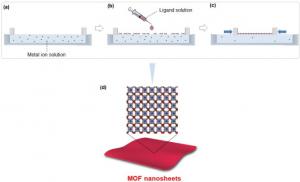 Over the past decade, significant progress has been made in research on metal–organic frameworks (MOFs) – highly ordered microporous materials composed of metal ions and organic linkers – resulting in an increased understanding of the relationship between framework structure/components and performance in various applications in diverse fields such as electronics, energy creation/storage and biomaterials. For most potential applications, organizing MOFs into two-dimensional (2D) thin films – nanosheets – is necessary. In order to create MOF nanosheets, two experimental approaches have been developed: top-down and bottom-up and most review papers on MOF nanosheets deal with these two methods. In this review, I focus on the bottom-up approach for creation of MOF nanosheets, a simple process with one or few steps that potentially offers access to large nanosheets with macroscopic continuity. Especially, the Langmuir-Blodgett (LB) methodology utilizing air/liquid interfaces is sequentially discussed. Because of the ultrathin state of nanosheets, characterization methods of MOF nanosheets often differ from those employed for bulk MOF crystals conducted with conventional techniques. Therefore, representative and useful techniques to determine nanosheet characteristics are explained in detail. Following that, I discuss the structural and morphological development of porphyrin- and triphenylene-based MOF nanosheets that critically influences their chemical/physical properties. Finally, I describe challenges and perspectives related to the LB synthesis towards further understanding of the growth mechanism at the interfaces, leading to extensive applications of MOF nanosheets.
Over the past decade, significant progress has been made in research on metal–organic frameworks (MOFs) – highly ordered microporous materials composed of metal ions and organic linkers – resulting in an increased understanding of the relationship between framework structure/components and performance in various applications in diverse fields such as electronics, energy creation/storage and biomaterials. For most potential applications, organizing MOFs into two-dimensional (2D) thin films – nanosheets – is necessary. In order to create MOF nanosheets, two experimental approaches have been developed: top-down and bottom-up and most review papers on MOF nanosheets deal with these two methods. In this review, I focus on the bottom-up approach for creation of MOF nanosheets, a simple process with one or few steps that potentially offers access to large nanosheets with macroscopic continuity. Especially, the Langmuir-Blodgett (LB) methodology utilizing air/liquid interfaces is sequentially discussed. Because of the ultrathin state of nanosheets, characterization methods of MOF nanosheets often differ from those employed for bulk MOF crystals conducted with conventional techniques. Therefore, representative and useful techniques to determine nanosheet characteristics are explained in detail. Following that, I discuss the structural and morphological development of porphyrin- and triphenylene-based MOF nanosheets that critically influences their chemical/physical properties. Finally, I describe challenges and perspectives related to the LB synthesis towards further understanding of the growth mechanism at the interfaces, leading to extensive applications of MOF nanosheets.
[36] "Uniaxially Oriented Electrically Conductive Metal–Organic Framework Nanosheets Assembled at Air/Liquid Interfaces"
Takashi Ohata, Akihiro Nomoto, Takeshi Watanabe, Ichiro Hirosawa, Tatsuyuki Makita, Jun Takeya, and Rie Makiura*
ACS Applied Materials & Interfaces, 13, 54570-54578 (2021). Supplementary Cover
https://pubs.acs.org/doi/10.1021/acsami.1c16180
Received: 26 August 2021; Accepted: 13 October 2021, Published online: 27 October 2021
Press Release by Osaka Prefecture University, Osaka Prefecture University (English), The University of Tokyo, The University of Tokyo (English), SPring-8/JASRI, SPring-8/JASRI (English), Highlighted in Nihon Keizai Shimbun, Nikkan Kogyo Shimbun, MynaviNews, EurekAlert!, AsiaResearchNews, AZONANO, ScienceDaily, Phys.org, Mirage.News, Nanowerk.
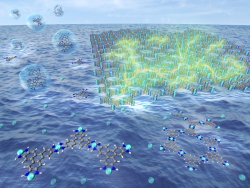
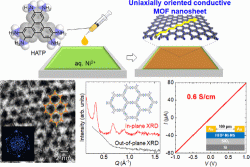
Although most metal–organic frameworks (MOFs)—highly porous crystalline metal complex networks with structural and functional varieties—are electrically insulating, high electrical conduction has been recently demonstrated in MOFs while retaining permanent porosity. Usability of electronically active MOFs effectively emerges when they are created in a thin-film state as required in major potential applications such as chemiresistive sensors, supercapacitors, and electrode catalysts. Thin-film morphology including crystallinity, thickness, density, roughness, and orientation sensitively influences device performance. Fine control of such morphological parameters still remains as a main issue to be addressed. Here, we report a bottom-up procedure of assembling a conductive MOF nanosheet composed of 2,3,6,7,10,11-hexaiminotriphenylene molecules and nickel ions (HITP-Ni-NS). Creation of HITP-Ni-NS is achieved by applying air/liquid (A/L) interfacial bottom-up synthesis. HITP-Ni-NS has a multilayered structure with 14 nm thickness and is endowed with high crystallinity and uniaxial orientation, demonstrated by synchrotron X-ray crystallography. Facile transferability of HITP-Ni-NS assembled at air/liquid interfaces to any desired substrate enables us to measure its electrical conductivity, recorded as 0.6 S cm-1—highest among those of triphenylene-based MOF nanosheets with a thickness lower than 100 nm.
[35] "Direct Causality between Film Formation and Water-Retaining Effect of Surfactant-Based Film-Forming Curing Compound for Concrete"
Yoko Ito, Yuya Sakai*, Rie Makiura, Seunghyun Na, and Taro Toyota
Journal of Building Engineering, 43, 102930 (2021).
https://doi.org/10.1016/j.jobe.2021.102930
Available online 29 June 2021
[34] "Air/Water Interfacial Monolayer Assembly of Peptide-Conjugated Liquid-Crystalline Molecules"
Rie Makiura*, Anna Niwa, Hiroki Eimura, Junya Uchida*, and Takashi Kato*
Bulletin of the Chemical Society of Japan, 94, 2060-2067 (2021).
https://doi.org/10.1246/bcsj.20210166
Received: 4 May 2021; Accepted: 3 June 2021; Web Released: 19 June 2021

Molecular arrangements of amphiphilic mesogens with tripeptides in monolayers assembled at air/water interfaces are studied. Because of bent structures, the amphiphilic mesogens exist in the liquid-expanded state. The measurements of atomic force microscopy and water contact angle of monolayers transferred on silicon imply that the rigid-rod moieties initially lie on the substrate then rise up by applied surface pressure.
2016-2020
[33] "Heteroatom-Doped Carbon Electrocatalysts Derived from Nanoporous Two-Dimensional Covalent Organic Frameworks for Oxygen Reduction and Hydrogen Evolution"
Chao Yang, Shanshan Tao, Ning Huang, Xiaobin Zhang, Jingui Duan*, Rie Makiura*, and Shinya Maenosono*
ACS Applied NanoMaterials, 3, 5481-5488 (2020).
https://pubs.acs.org/doi/10.1021/acsanm.0c00786
Received:24 March 2020, Accepted:15 May 2020, Published online:1 June 2020

Electrocatalytic oxygen reduction reaction (ORR) and hydrogen evolution reaction (HER) are vital in the renewable energy platform, particularly fuel cells and rechargeable batteries, where construction of efficient electrocatalysts is a crucial task. In contrast to noble-metal catalysts, heteroatom-doped carbons have recently emerged as new-generation electrocatalysts because of their low cost and high stability/activity. Although unique features of covalent organic frameworks (COFs) including high surface areas, adjustable apertures, and easy introduction of diverse heteroatoms render them promising precursors for heteroatom-doped carbons, development of electrocatalysts derived from COFs with simultaneously high activities of ORR/HER is still at an early stage. Here, we report the creation of metal-free heteroatom-doped carbon catalysts derived from four types of newly designed nanoporous two-dimensional COFs with ordered pores smaller than 1 nm. Both preincorporated N in the pristine COFs and postdoped P heteroatoms are uniformly distributed into the graphitized carbons and functioning as effective active sites for electrocatalysis. Furthermore, the obtained heteroatom (N, P) codoped carbons possess nanoporosity beneficial for efficient introduction of reactants. Therefore, the N, P codoped nanoporous carbons demonstrate robust electrochemical performances for both ORR and HER with a half-wave potential of 0.81 V in alkaline medium and low overpotential of 260 mV in acid solutions. In addition, their catalytic activities are not changed after a long-time cycle. These findings will promote creation of robust COF-derived carbon catalysts in energy storage and conversion as well as development of new COFs with tunable nanopores.
[32] "界面活性剤系被膜養生剤による水分蒸発抑制効果に関する研究 Water-Retaining Effect of Surfactant-Based Membrane-Forming Curing Compounds"
伊藤遥子、酒井雄也*、牧浦理恵、豊田太郎
第19回 コンクリート構造物の補修,補強,アップグレードシンポジウム, 150-160 (2019).
Published on October 2019
[31] "ブリュースター角顕微鏡による界面活性剤系被膜養生剤の観察"
伊藤遥子、酒井雄也、牧浦理恵
生産研究, 2019, 71巻, 1号, p.51-54 (2019).
https://doi.org/10.11188/seisankenkyu.71.51
Published on 31 January 2019
[30] "Controlled Release of DNA from Zinc and Magnesium Ion-Doped Hydroxyapatites"
Chie Kojima*, Kenji Watanabe, Hidenobu Murata, Yuki Nishio, Rie Makiura, Katsuyuki Matsunaga, and Atsushi Nakahira
Research on Chemical Intermediates, 45, 23-32 (2019).
https://doi.org/10.1007/s11164-018-3626-3
First Online: 11 October 2018
[29] "Influence of Solution pH and Reaction Atmosphere on the Morphology of SrTiO3 Nanocubes Synthesized by Thermohydrolysis"
Rie Makiura*
Research on Chemical Intermediates, 44, 4775-4782 (2018).
https://doi.org/10.1007/s11164-018-3283-6
First Online: 24 January 2018
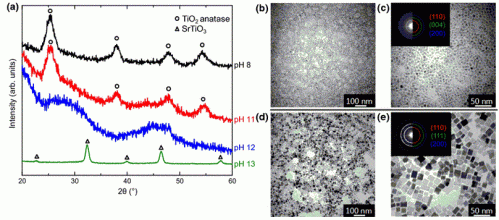
The influence of synthetic conditions on the shape and size of SrTiO3 (STO) nanocubes was studied. These were synthesized in aqueous solution using Sr(OH)2 as the Sr2+ source and titanium(IV) bis(ammonium lactate)dihydroxide (TALH) as the TiIV source in the presence of oleic acid and hydrazine. A large excess of OH− at a pH of the precursor solution higher than 12 is necessary for the formation of STO nanocubes without the need for any calcination. Performing the synthesis in a N2 atmosphere additionally prevents the formation of SrCO3 impurity, leading to the creation of uniformly sized STO nanocubes in a reproducible manner. Such size-regulated STO nanocubes are found to align over a large area.
[28] "液相界面ボトムアップ法による分離膜向け分子ナノシートの創製と構造解析 Structural Analysis of Molecular Naonsheets for Separation Membrane Assembled with a Bottom‒Up Approach at Liquid Interfaces"
Takashi Ohata, Ichiro Hirosawa, Takeshi Watanabe, and Rie Makiura*
SPring-8 / SACLA Research Report, 6, 2016B1862 / BL19B2 (2017).
https://doi.org/10.18957/rr.6.1.137
Received: June 29, 2017; Early edition: November 24, 2017
[27] "Air/Liquid Interfacial Nanoassembly of Molecular Building Blocks into Preferentially-Oriented Porous Organic Nanosheet Crystals via Hydrogen Bonding"
Rie Makiura*, Kohei Tsuchiyama, Ehmke Pohl, Kosmas Prassides, Osami Sakata, Hiroo Tajiri, and Oleg Konovalov
ACS Nano, 11, 10875–10882 (2017). Open Access
https://doi.org/10.1021/acsnano.7b04447
Publication Date (Web): October 24, 2017
 Nanosheets with highly regulated nanopores are ultimately thin functional materials for diverse applications including molecular separation and detection, catalysis, and energy conversion and storage. However, their availability has hitherto been restricted to layered parent materials, covalently bonded sheets, which are layered via relatively weak electrostatic interactions. Here, we report a rational bottom-up methodology that enables nanosheet creation beyond the layered systems. We employ the air/liquid interface to assemble a triphenylbenzene derivative into perfectly oriented highly crystalline noncovalent-bonded organic nanosheets under ambient conditions. Each molecular building unit connects laterally by hydrogen bonding, endowing the nanosheets with size- and position-regulated permanent nanoporosity, as established by in situ synchrotron X-ray surface crystallography and gas sorption measurements. Notably, the nanosheets are constructed specifically by interfacial synthesis, which suppresses the intrinsic complex interpenetrated structure of the bulk crystal. Moreover, they possess exceptional long-term and thermal stability and are easily transferrable to numerous substrates without loss of structural integrity. Our work shows the power of interfacial synthesis using a suitably chosen molecular component to create two-dimensional (2D) nanoassemblies not accessible by conventional bulk crystal exfoliation techniques.
Nanosheets with highly regulated nanopores are ultimately thin functional materials for diverse applications including molecular separation and detection, catalysis, and energy conversion and storage. However, their availability has hitherto been restricted to layered parent materials, covalently bonded sheets, which are layered via relatively weak electrostatic interactions. Here, we report a rational bottom-up methodology that enables nanosheet creation beyond the layered systems. We employ the air/liquid interface to assemble a triphenylbenzene derivative into perfectly oriented highly crystalline noncovalent-bonded organic nanosheets under ambient conditions. Each molecular building unit connects laterally by hydrogen bonding, endowing the nanosheets with size- and position-regulated permanent nanoporosity, as established by in situ synchrotron X-ray surface crystallography and gas sorption measurements. Notably, the nanosheets are constructed specifically by interfacial synthesis, which suppresses the intrinsic complex interpenetrated structure of the bulk crystal. Moreover, they possess exceptional long-term and thermal stability and are easily transferrable to numerous substrates without loss of structural integrity. Our work shows the power of interfacial synthesis using a suitably chosen molecular component to create two-dimensional (2D) nanoassemblies not accessible by conventional bulk crystal exfoliation techniques.[26] "Solution-Based Sequential Modification of LiCoO2 Particle Surfaces with Iron(II) Oxalate Nanolayers"
Yuki Kishimoto, So Yubuchi, Akitoshi Hayashi, Masahiro Tatsumisago, and Rie Makiura*
CrysEngComm, 19, 4175-4181 (2017).
https://doi.org/10.1039/C7CE00552K
First published on 19 May 2017
 Hybridization of metal–organic frameworks (MOFs) with other inorganic materials offers the opportunity to enhance their properties or open new windows for potential applications. Formation of core/shell structures, in which the core is the inorganic particle and the shell is the surface-deposited MOF, is one of the rational methodologies to create such hybrid materials. Here, we present the facile creation of metal oxide-core/MOF-shell structures by applying a solution-based step-by-step modification of the core surface using a framework compound. The modification procedure includes alternate immersion of LiCoO2 (LCO) – a catalyst for the oxygen evolution reaction – into oxalic acid and ferrous solutions, resulting in the formation of iron(II) oxalate (Fe(ox), ox = oxalate anion) – one of the simplest MOFs with short unit frameworks – nanolayers on the LCO surface (Fe(ox)NL@LCO). The amount of deposited Fe(ox) does not increase monotonically with the number of the modification cycles, but tends to saturate rapidly, implying that the Fe(ox) framework grows laterally on the LCO surface. An increase of the electrical resistivity of the LCO particles that influences adversely catalytic activity is suppressed when a high coverage of the LCO surface by the Fe(ox) framework is achieved at subsequent modification cycles.
Hybridization of metal–organic frameworks (MOFs) with other inorganic materials offers the opportunity to enhance their properties or open new windows for potential applications. Formation of core/shell structures, in which the core is the inorganic particle and the shell is the surface-deposited MOF, is one of the rational methodologies to create such hybrid materials. Here, we present the facile creation of metal oxide-core/MOF-shell structures by applying a solution-based step-by-step modification of the core surface using a framework compound. The modification procedure includes alternate immersion of LiCoO2 (LCO) – a catalyst for the oxygen evolution reaction – into oxalic acid and ferrous solutions, resulting in the formation of iron(II) oxalate (Fe(ox), ox = oxalate anion) – one of the simplest MOFs with short unit frameworks – nanolayers on the LCO surface (Fe(ox)NL@LCO). The amount of deposited Fe(ox) does not increase monotonically with the number of the modification cycles, but tends to saturate rapidly, implying that the Fe(ox) framework grows laterally on the LCO surface. An increase of the electrical resistivity of the LCO particles that influences adversely catalytic activity is suppressed when a high coverage of the LCO surface by the Fe(ox) framework is achieved at subsequent modification cycles.2011-2015
[25] "Optimization of Dendrimer Structure for Sentinel Lymph Node Imaging: Effects of Generation and Terminal Group"
Yuichiro Niki, Mikako Ogawa, Rie Makiura, Yasuhiro Magata, and Chie Kojima*
Nanomedicine: NBM, 11, 2119-2127 (2015).
https://doi.org/10.1016/j.nano.2015.08.002
Available online 5 September 2015
 The detection of the sentinel lymph node (SLN), the first lymph node draining tumor cells, is important in cancer diagnosis and therapy. Dendrimers are synthetic macromolecules with highly controllable structures, and are potent multifunctional imaging agents. In this study, 12 types of dendrimer of different generations (G2, G4, G6, and G8) and different terminal groups (amino, carboxyl, and acetyl) were prepared to determine the optimal dendrimer structure for SLN imaging. Radiolabeled dendrimers were intradermally administrated to the right footpads of rats. All G2 dendrimers were predominantly accumulated in the kidney. Amino-terminal, acetyl-terminal, and carboxyl-terminal dendrimers of greater than G4 were mostly located at the injection site, in the blood, and in the SLN, respectively. The carboxyl-terminal dendrimers were largely unrecognized by macrophages and T-cells in the SLN. Finally, SLN detection was successfully performed by single photon emission computed tomography imaging using carboxyl-terminal dendrimers of greater than G4.
The detection of the sentinel lymph node (SLN), the first lymph node draining tumor cells, is important in cancer diagnosis and therapy. Dendrimers are synthetic macromolecules with highly controllable structures, and are potent multifunctional imaging agents. In this study, 12 types of dendrimer of different generations (G2, G4, G6, and G8) and different terminal groups (amino, carboxyl, and acetyl) were prepared to determine the optimal dendrimer structure for SLN imaging. Radiolabeled dendrimers were intradermally administrated to the right footpads of rats. All G2 dendrimers were predominantly accumulated in the kidney. Amino-terminal, acetyl-terminal, and carboxyl-terminal dendrimers of greater than G4 were mostly located at the injection site, in the blood, and in the SLN, respectively. The carboxyl-terminal dendrimers were largely unrecognized by macrophages and T-cells in the SLN. Finally, SLN detection was successfully performed by single photon emission computed tomography imaging using carboxyl-terminal dendrimers of greater than G4.[24] "Liquid-Phase Step-by-Step Growth of an Iron Cyanide Coordination Framework on LiCoO2 Particle Surfaces"
Rie Makiura*, Shingo Teragawa, Kohei Tsuchiyama, Akitoshi Hayashi, Kiyoharu Tadanaga, and Masahiro Tatsumisago
Dalton Transactions, 44, 15279-15287 (2015).
https://doi.org/10.1039/C5DT00968E
First published online 13 May 2015
 Surface modification of inorganic objects with metal-organic frameworks (MOFs) –organic-inorganic hybrid framework materials with infinite networks– opens wide windows for potential applications. In order to derive a target property, the key is the ability to fine tune the degree of modification. Solution-based step-by-step growth techniques provide excellent control of layer thickness which can be varied with the number of deposition cycles. Such techniques with MOFs have been mainly applied to flat substrates, but not to particle surfaces before. Here, we present the facile surface modification of inorganic particles with a framework compound under operationally simple ambient conditions. A solution-based sequential technique involving the alternate immersion of LiCoO2 (LCO) –a positive electrode material for a lithium ion battery– into FeCl2•4H2O and K3[Fe(CN)6] solutions results in the formation of Prussian blue (PB) nanolayers on the surface of the LCO particles (PBNL@LCO). The PB growth is finely controlled by the number of immersion cycles. An electrochemical cell with PBNL@LCO as a positive electrode material exhibits a discharge capacity close to the specific capacity of LCO. The results open a new direction for creating suitable interfacial conditions between electrode materials and electrolytes in secondary battery materials.
Surface modification of inorganic objects with metal-organic frameworks (MOFs) –organic-inorganic hybrid framework materials with infinite networks– opens wide windows for potential applications. In order to derive a target property, the key is the ability to fine tune the degree of modification. Solution-based step-by-step growth techniques provide excellent control of layer thickness which can be varied with the number of deposition cycles. Such techniques with MOFs have been mainly applied to flat substrates, but not to particle surfaces before. Here, we present the facile surface modification of inorganic particles with a framework compound under operationally simple ambient conditions. A solution-based sequential technique involving the alternate immersion of LiCoO2 (LCO) –a positive electrode material for a lithium ion battery– into FeCl2•4H2O and K3[Fe(CN)6] solutions results in the formation of Prussian blue (PB) nanolayers on the surface of the LCO particles (PBNL@LCO). The PB growth is finely controlled by the number of immersion cycles. An electrochemical cell with PBNL@LCO as a positive electrode material exhibits a discharge capacity close to the specific capacity of LCO. The results open a new direction for creating suitable interfacial conditions between electrode materials and electrolytes in secondary battery materials.[23] "External Stimulation-Controllable Heat-Storage Ceramics"
Hiroko Tokoro, Marie Yoshikiyo, Kenta Imoto, Asuka Namai, Tomomichi Nasu, Kosuke Nakagawa, Noriaki Ozaki, Fumiyoshi Hakoe, Kenji Tanaka, Kouji Chiba, Rie Makiura, Kosmas Prassides, and Shin-ichi Ohkoshi*
Nature Communications, 6, 7037 (2015). Open Access
https://doi.org/10.1038/ncomms8037
Published 12 May 2015
 Commonly available heat-storage materials cannot usually store the energy for a prolonged period. If a solid material could conserve the accumulated thermal energy, then its heat-storage application potential is considerably widened. Here we report a phase transition material that can conserve the latent heat energy in a wide temperature range, T<530 K and release the heat energy on the application of pressure. This material is stripe-type lambda-trititanium pentoxide, λ-Ti3O5, which exhibits a solid–solid phase transition to beta-trititanium pentoxide, β-Ti3O5. The pressure for conversion is extremely small, only 600 bar (60 MPa) at ambient temperature, and the accumulated heat energy is surprisingly large (230 kJ L−1). Conversely, the pressure-produced beta-trititanium pentoxide transforms to lambda-trititanium pentoxide by heat, light or electric current. That is, the present system exhibits pressure-and-heat, pressure-and-light and pressure-and-current reversible phase transitions. The material may be useful for heat storage, as well as in sensor and switching memory device applications.
Commonly available heat-storage materials cannot usually store the energy for a prolonged period. If a solid material could conserve the accumulated thermal energy, then its heat-storage application potential is considerably widened. Here we report a phase transition material that can conserve the latent heat energy in a wide temperature range, T<530 K and release the heat energy on the application of pressure. This material is stripe-type lambda-trititanium pentoxide, λ-Ti3O5, which exhibits a solid–solid phase transition to beta-trititanium pentoxide, β-Ti3O5. The pressure for conversion is extremely small, only 600 bar (60 MPa) at ambient temperature, and the accumulated heat energy is surprisingly large (230 kJ L−1). Conversely, the pressure-produced beta-trititanium pentoxide transforms to lambda-trititanium pentoxide by heat, light or electric current. That is, the present system exhibits pressure-and-heat, pressure-and-light and pressure-and-current reversible phase transitions. The material may be useful for heat storage, as well as in sensor and switching memory device applications.[22] "Towards Rational Modulation of In-Plane Molecular Arrangements in Metal-Organic Framework Nanosheets"
Rie Makiura*, Ryo Usui, Yuta Sakai, Akihiro Nomoto, Akiya Ogawa, Osami Sakata, and Akihiko Fujiwara
ChemPlusChem, 79, 1352-1360 (2014). Open Access
https://doi.org/10.1002/cplu.201402150
Early View Online 18 Jul 2014
Highlighted in Wiley-Japan Science Cafe Most accessed for Dec 2014 (Wiley-Japan Science Cafe / ChemistryViews)
 A strategy to modulate the in-plane structural arrangement in preferentially oriented crystalline metal–organic framework (MOF) nanosheets assembled by a two-dimensional interfacial reaction between porphyrin units and metal ion linkers is reported. Starting with a tetratopic porphyrin MOF nanofilm, NAFS-2, the framework size and shape are modified by employing specially designed building units, a trans-ditopic and an expanded tetratopic porphyrin, and Cu2+ linkers. Reducing the number of binding parts affords a MOF nanosheet, NAFS-31, with a distorted in-plane structure. Extension of the peripheral substituents, while maintaining the tetratopic porphyrin geometry, results in marked unit cell size enlargement in an undistorted square grid in the MOF nanofilm, NAFS-41. The exquisite geometric control that these structural modifications entail is valuable to allow switching of chemical/physical properties of the nanosheets and lead to realization of their use in nanotechnological applications.
A strategy to modulate the in-plane structural arrangement in preferentially oriented crystalline metal–organic framework (MOF) nanosheets assembled by a two-dimensional interfacial reaction between porphyrin units and metal ion linkers is reported. Starting with a tetratopic porphyrin MOF nanofilm, NAFS-2, the framework size and shape are modified by employing specially designed building units, a trans-ditopic and an expanded tetratopic porphyrin, and Cu2+ linkers. Reducing the number of binding parts affords a MOF nanosheet, NAFS-31, with a distorted in-plane structure. Extension of the peripheral substituents, while maintaining the tetratopic porphyrin geometry, results in marked unit cell size enlargement in an undistorted square grid in the MOF nanofilm, NAFS-41. The exquisite geometric control that these structural modifications entail is valuable to allow switching of chemical/physical properties of the nanosheets and lead to realization of their use in nanotechnological applications.[21] "Porphyrin-Based Coordination Polymer Composed of Layered Pillarless Two-Dimensional Networks"
Rie Makiura*, Ryo Usui, Ehmke Pohl, and Kosmas Prassides
Chemistry Letters, 43, 1161-1163 (2014). Open Access
https://doi.org/10.1246/cl.140275
Advance online publication 14 April 2014 Released on J-STAGE 5 July 2014
 Single crystals of a layer-structured coordination polymer, BNAS-11 [ZnTCPP(H2O)Zn2(H2O)2] (ZnTCPP:5,10,15,20-tetrakis(4-carboxyphenyl) porphyrinatozinc(II)), were obtained. Tetratopic ZnTCPP molecules are connected through dimer zinc paddle-wheel secondary building units and form a two-dimensional (2D) network with square grids. The layers are stacked electrostatically without the need of binding pillar ligands.
Single crystals of a layer-structured coordination polymer, BNAS-11 [ZnTCPP(H2O)Zn2(H2O)2] (ZnTCPP:5,10,15,20-tetrakis(4-carboxyphenyl) porphyrinatozinc(II)), were obtained. Tetratopic ZnTCPP molecules are connected through dimer zinc paddle-wheel secondary building units and form a two-dimensional (2D) network with square grids. The layers are stacked electrostatically without the need of binding pillar ligands.[20] "EQCM Analysis of Redox Behavior of Prussian Blue in a Lithium Battery Electrolyte"
Shunsuke Yagi*, Masaaki Fukuda, Rie Makiura, Tetsu Ichitsubo, and Eiichiro Matsubara
Journal of Materials Chemistry A, 2, 8041-8047 (2014).
/https:/doi.org/10.1039/C4TA00410H
Published online 14 Mar 2014
 Prussian blue (PB) and its analogues (PBAs) have been intensively studied and are now increasingly attractive for battery applications in particular because of their ability to accommodate a wide variety of ions including polyvalent cations. The redox reactions of PB and PBAs are believed to be very fast and reversible. However, it is not always true. In this paper, we clarify the detailed redox behavior of PB in an electrolyte for Li (ion) batteries using an electrochemical quartz crystal microbalance under an Ar atmosphere. We quantitatively report for the first time that the electrochemical adsorption/desorption of PF6− ions occurs in addition to the insertion/extraction of Li+ ions upon the redox reactions of PB. The adsorption of PF6− ions is followed by the extraction of Li+ ions during the oxidation of PB, and the adsorbed PF6− ions hinder the extraction of the Li+ ions. In contrast, the adsorbed PF6− ions do not affect Li+ ion insertion because the PF6− ions are desorbed before the insertion of Li+ ions during the reduction of PB. These results show that for practical applications the size of the framework structure should be selected by comparing the anion size in addition to the cation size.
Prussian blue (PB) and its analogues (PBAs) have been intensively studied and are now increasingly attractive for battery applications in particular because of their ability to accommodate a wide variety of ions including polyvalent cations. The redox reactions of PB and PBAs are believed to be very fast and reversible. However, it is not always true. In this paper, we clarify the detailed redox behavior of PB in an electrolyte for Li (ion) batteries using an electrochemical quartz crystal microbalance under an Ar atmosphere. We quantitatively report for the first time that the electrochemical adsorption/desorption of PF6− ions occurs in addition to the insertion/extraction of Li+ ions upon the redox reactions of PB. The adsorption of PF6− ions is followed by the extraction of Li+ ions during the oxidation of PB, and the adsorbed PF6− ions hinder the extraction of the Li+ ions. In contrast, the adsorbed PF6− ions do not affect Li+ ion insertion because the PF6− ions are desorbed before the insertion of Li+ ions during the reduction of PB. These results show that for practical applications the size of the framework structure should be selected by comparing the anion size in addition to the cation size.[19] "Micropattern Formation by Molecular Migration via UV-Induced Dehydration of Block Copolymers"
Kenji Okada, Yasuaki Tokudome, Rie Makiura, Kristina Konstas, Luca Malfatti, Plinio Innocenzi, Hiroki Ogawa, Toshiji Kanaya, Paolo Falcaro, and Masahide Takahashi*
Advanced Functional Materials, 24, 2801-2809 (2014).
https://doi.org/10.1002/adfm.201302812
Published online 23 January 2014
 A novel UV lithographic technique for the patterning of the block copolymer (Pluronic) thin films is developed. The present method is based on UV-induced water affinity changes in block copolymer films. By water vapor post-treatment of the film, a difference in water content is established between UV illuminated and unilluminated sections, which can induce an osmotic pressure at the interface. This osmotic pressure drives the migration of Pluronic molecules, resulting in formation of patterns on the block copolymer films. Remarkably, this patterning method requires neither initiators nor polymerizable moieties which are essential for a conventional photolithographic approach. Additionally, the etching process is bypassed, eliminating the use of destructive acids or organic solvents and making this an environmentally friendly patterning protocol. It is reported that Pluronic is photo-responsive to UV exposure, which causes the dehydration of the PEO-PPO-PEO backbone.
A novel UV lithographic technique for the patterning of the block copolymer (Pluronic) thin films is developed. The present method is based on UV-induced water affinity changes in block copolymer films. By water vapor post-treatment of the film, a difference in water content is established between UV illuminated and unilluminated sections, which can induce an osmotic pressure at the interface. This osmotic pressure drives the migration of Pluronic molecules, resulting in formation of patterns on the block copolymer films. Remarkably, this patterning method requires neither initiators nor polymerizable moieties which are essential for a conventional photolithographic approach. Additionally, the etching process is bypassed, eliminating the use of destructive acids or organic solvents and making this an environmentally friendly patterning protocol. It is reported that Pluronic is photo-responsive to UV exposure, which causes the dehydration of the PEO-PPO-PEO backbone.[18] "Toward Step-by-Step Nuclear Growth of Surface Two-Dimensional Porphyrin Nanonetworks"
Rie Makiura*, Hiroshi Kitagawa*, Yasuyuki Akita, and Mamoru Yoshimoto
Journal of Colloid and Interface Science, 413, 71-77 (2014). Editor's Choice
https://doi.org/10.1016/j.jcis.2013.09.024
Published on 25 September 2013 Top cover image
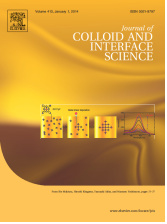
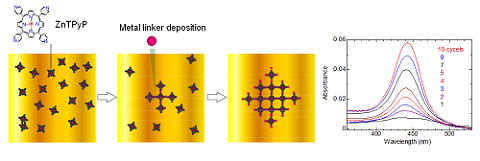
We report the development of a solution-based step-by-step technique, which utilizes the coordination bond between metalloporphyrin molecular units and metal linkages and results in the nuclear growth of nano-networks on solid substrates. The growth of the surface structures is strongly influenced by the choice of substrate materials and solvents: the molecule-substrate interaction and the solubility of the molecular units are important parameters in tuning the size and growth of the domains.
[17] "Bottom-Up Assembly of Ultrathin Sub-Micron Size Metal-Organic Framework Sheets"
Rie Makiura* and Oleg Konovalov
Dalton Transactions, 42, 15931-15936 (2013). Open Access
https://doi.org/10.1039/C3DT51703A
Published on 3 September 2013
 Solution-based two-dimensional interfacial reaction between 5,10,15,20-tetra(4-pyridyl)-porphinato zinc(II) (ZnTPyP) and Cu(NO3)2•3H2O results in the assembly of uniform preferentially oriented highly crystalline metal-organic framework nanosheets, NAFS-21 with sub-micron planar size and mono-molecular thickness.
Solution-based two-dimensional interfacial reaction between 5,10,15,20-tetra(4-pyridyl)-porphinato zinc(II) (ZnTPyP) and Cu(NO3)2•3H2O results in the assembly of uniform preferentially oriented highly crystalline metal-organic framework nanosheets, NAFS-21 with sub-micron planar size and mono-molecular thickness.[16] "Preparation of Hydroxyapatite-Decorated Poly(Lactide-co-Glycolide) Microspheres for Paclitaxel Delivery"
Chie Kojima*, Kenji Watanabe, Takashi Nagayasu, Yuki Nishio, Rie Makiura and Atsushi Nakahira
Journal of Nanoparticle Research, 15, 2098/1-2098/11 (2013).
https://doi.org/10.1007/s11051-013-2098-z
Published on 7 November 2013
 Paclitaxel (Tax) is an anticancer drug with extremely low water solubility, and development of the formulation without organic solvents is highly desirable. Hydroxyapatite (HA) is a biocompatible and porous inorganic material that can be used effectively in drug delivery systems, but poor dispersibility in water limits its application. In this study, HA-decorated poly(lactide-co-glycolide) (PLG) spheres with several micrometers were prepared and characterized. PLG microspheres adsorbed Tax, independent in the HA decorating, and their water dispersibility was retained after the HA decorating. Tax-loaded HA-decorated PLG microspheres (Tax/HA/PLG) could thus be highly dispersed in water, increasing their cellular uptake. Most Tax molecules were stably adsorbed to the HA and HA-decorated PLG (HA/PLG) particles. Although the cytotoxicity of Tax-loaded HA was much lower than that of free Tax, the drug activity of Tax/HA/PLG was markedly improved. Since the morphology of microtubules was changed after the Tax/HA/PLG treatment, the HA/PLG could work as a carrier for Tax.
Paclitaxel (Tax) is an anticancer drug with extremely low water solubility, and development of the formulation without organic solvents is highly desirable. Hydroxyapatite (HA) is a biocompatible and porous inorganic material that can be used effectively in drug delivery systems, but poor dispersibility in water limits its application. In this study, HA-decorated poly(lactide-co-glycolide) (PLG) spheres with several micrometers were prepared and characterized. PLG microspheres adsorbed Tax, independent in the HA decorating, and their water dispersibility was retained after the HA decorating. Tax-loaded HA-decorated PLG microspheres (Tax/HA/PLG) could thus be highly dispersed in water, increasing their cellular uptake. Most Tax molecules were stably adsorbed to the HA and HA-decorated PLG (HA/PLG) particles. Although the cytotoxicity of Tax-loaded HA was much lower than that of free Tax, the drug activity of Tax/HA/PLG was markedly improved. Since the morphology of microtubules was changed after the Tax/HA/PLG treatment, the HA/PLG could work as a carrier for Tax.[15] "Interfacial Growth of Large-Area Single-Layer Metal-Organic Framework Nanosheets"
Rie Makiura* and Oleg Konovalov
Scientific Reports, 3, 2506 (2013). Open Access
https://doi.org/10.1038/srep02506
Published on 26 August 2013
 The air/liquid interface is an excellent platform to assemble two-dimensional (2D) sheets of materials by enhancing spontaneous organizational features of the building components and encouraging large length scale in-plane growth. We have grown 2D molecularly-thin crystalline metal-organic-framework (MOF) nanosheets composed of porphyrin building units and metal-ion joints (NAFS-13) under operationally simple ambient conditions at the air/liquid interface. In-situ synchrotron X-ray diffraction studies of the formation process performed directly at the interface were employed to optimize the NAFS-13 growth protocol leading to the development of a post-injection method –post-injection of the metal connectors into the water subphase on whose surface the molecular building blocks are pre-oriented– which allowed us to achieve the formation of large-surface area morphologically-uniform preferentially-oriented single-layer nanosheets. The growth of such large-size high-quality sheets is of interest for the understanding of the fundamental physical/chemical properties associated with ultra-thin sheet-shaped materials and the realization of their use in applications.
The air/liquid interface is an excellent platform to assemble two-dimensional (2D) sheets of materials by enhancing spontaneous organizational features of the building components and encouraging large length scale in-plane growth. We have grown 2D molecularly-thin crystalline metal-organic-framework (MOF) nanosheets composed of porphyrin building units and metal-ion joints (NAFS-13) under operationally simple ambient conditions at the air/liquid interface. In-situ synchrotron X-ray diffraction studies of the formation process performed directly at the interface were employed to optimize the NAFS-13 growth protocol leading to the development of a post-injection method –post-injection of the metal connectors into the water subphase on whose surface the molecular building blocks are pre-oriented– which allowed us to achieve the formation of large-surface area morphologically-uniform preferentially-oriented single-layer nanosheets. The growth of such large-size high-quality sheets is of interest for the understanding of the fundamental physical/chemical properties associated with ultra-thin sheet-shaped materials and the realization of their use in applications.[14] "Designer Coordination Polymers: Dimensional Crossover Architectures and Proton Conduction"
Teppei Yamada, Kazuya Otsubo, Rie Makiura, and Hiroshi Kitagawa*
Chemical Society Reviews, 42, 6655–6669 (2013).
https://doi.org/10.1039/C3CS60028A
Published on 1 July 2013 Inside front cover
 Coordination polymers (CPs) have large degrees of freedom in framework compositions and in the structures and environment of the inner pores. This review focuses on the recent significant progress achieved by controlling these degrees of freedom. Two breakthroughs are reviewed for constructing sophisticated structures of CP frameworks, especially in dimensional crossover regions. The first is the synthesis of quasi one-dimensional halogen-bridged coordinative tubes by applying state-of-the-art techniques of coordination chemistry. The electronic state of the coordinative tube was studied by structural, spectroscopic and theoretical methods and found to be distinct from conventional one-dimensional systems. The second breakthrough is the achievement of a quasi-two-dimensional architecture by combining Langmuir–Blodgett and layer-by-layer methods. Two-dimensional LB CP films were prepared on liquid; the films were stacked layer by layer, and a crystalline quasi-two-dimensional structure was constructed.
Coordination polymers (CPs) have large degrees of freedom in framework compositions and in the structures and environment of the inner pores. This review focuses on the recent significant progress achieved by controlling these degrees of freedom. Two breakthroughs are reviewed for constructing sophisticated structures of CP frameworks, especially in dimensional crossover regions. The first is the synthesis of quasi one-dimensional halogen-bridged coordinative tubes by applying state-of-the-art techniques of coordination chemistry. The electronic state of the coordinative tube was studied by structural, spectroscopic and theoretical methods and found to be distinct from conventional one-dimensional systems. The second breakthrough is the achievement of a quasi-two-dimensional architecture by combining Langmuir–Blodgett and layer-by-layer methods. Two-dimensional LB CP films were prepared on liquid; the films were stacked layer by layer, and a crystalline quasi-two-dimensional structure was constructed.[13] "Paclitaxel-Loaded Hydroxyapatite/Collagen Hybrid Gels as Drug Delivery Systems for Metastatic Cancer Cells"
Kenji Watanabe, Yuki Nishio, Rie Makiura, Atsushi Nakahira, and Chie Kojima*
International Journal of Pharmaceutics, 446, 81–86 (2013).
https://doi.org/10.1016/j.ijpharm.2013.02.002
Published on 10 February 2013 Inside front cover
 Hydroxyapatite (HA) is a biocompatible and porous inorganic material that can behave as an effective drug carrier. In this study, HA nanoparticles were prepared according to the hydrothermal method and used as a drug carrier for a water-insoluble anticancer drug, paclitaxel (Tax). The absorption of Tax onto the HA was dependent on the solvent composition. The Tax-loaded HA (Tax/HA) exhibited a lower level of activity than the free Tax because the HA material was not stably dispersed in aqueous media. The Tax/HA was therefore embedded in a collagen gel to give the Tax/HA-embedded collagen gel (Tax/HA/Col), which exhibited a higher level of activity than the Tax-containing collagen gel (Tax/Col). Interestingly, the highly metastatic MDA-MB-231 cells were more sensitive to the Tax/HA/Col than the poorly metastatic MCF-7 cells. Tax/HA/Col is therefore useful for the drug delivery into metastatic cancer cells.
Hydroxyapatite (HA) is a biocompatible and porous inorganic material that can behave as an effective drug carrier. In this study, HA nanoparticles were prepared according to the hydrothermal method and used as a drug carrier for a water-insoluble anticancer drug, paclitaxel (Tax). The absorption of Tax onto the HA was dependent on the solvent composition. The Tax-loaded HA (Tax/HA) exhibited a lower level of activity than the free Tax because the HA material was not stably dispersed in aqueous media. The Tax/HA was therefore embedded in a collagen gel to give the Tax/HA-embedded collagen gel (Tax/HA/Col), which exhibited a higher level of activity than the Tax-containing collagen gel (Tax/Col). Interestingly, the highly metastatic MDA-MB-231 cells were more sensitive to the Tax/HA/Col than the poorly metastatic MCF-7 cells. Tax/HA/Col is therefore useful for the drug delivery into metastatic cancer cells.[12] "Single-Molecule Imaging of Gold-Binding Peptide Adsorbed on Au(111)"
Satoshi Kanata, Tomoaki Nishino*, Rie Makiura, Sho Saiki, and Nobuhiko Hayashi
Analytical Science., 29, 405-409 (2013). Hot article
https://doi.org/10.2116/analsci.29.405
Published on 10 April 2013
 We report on the single-molecule analysis of such polypeptides by scanning tunneling microscopy (STM). The adsorbed structure of a gold-binding peptide (GBP) on Au(111) was observed at the single-molecule level. FTIR spectroscopy revealed the helical structure of the GBP, and ab initio calculations confirmed the correlation between the observed STM image and a sample helical structure. It has been demonstrated that the conformational structure of the polypeptide is highly pre-organized, allowing favorable binding onto the gold surface.
We report on the single-molecule analysis of such polypeptides by scanning tunneling microscopy (STM). The adsorbed structure of a gold-binding peptide (GBP) on Au(111) was observed at the single-molecule level. FTIR spectroscopy revealed the helical structure of the GBP, and ab initio calculations confirmed the correlation between the observed STM image and a sample helical structure. It has been demonstrated that the conformational structure of the polypeptide is highly pre-organized, allowing favorable binding onto the gold surface.[11] "Self-Assembly of Highly Crystalline Two-Dimensional MOF Sheets on Liquid Surfaces"
Rie Makiura*, Kohei Tsuchiyama, and Osami Sakata
CrystEngComm, 13, 5538-5541 (2011).
https://doi.org/10.1039/C1CE05684K
Published on 20 July 2011
 The formation process of the highly crystalline MOF nanosheet, NAFS-1 at the liquid surface was studied by UV-visible spectroscopy and synchrotron grazing incidence X-ray diffraction – self-assembly of the molecular building metalloporphyrin units and the metal ion joints occurs through a coordination reaction at the air/liquid interface without the necessity of pressing the surface.
The formation process of the highly crystalline MOF nanosheet, NAFS-1 at the liquid surface was studied by UV-visible spectroscopy and synchrotron grazing incidence X-ray diffraction – self-assembly of the molecular building metalloporphyrin units and the metal ion joints occurs through a coordination reaction at the air/liquid interface without the necessity of pressing the surface.[10] "Nanoscale Effects on the Stability of the Lambda-Ti3O5 Polymorph"
Rie Makiura*, Yasuhiro Takabayashi, Andrew N. Fitch, Hiroko Tokoro, Shin-ichi Ohkoshi, and Kosmas Prassides*
Chemistry - an. Asian Journal, 6, 1886–1890 (2011).
https://doi.org/10.1002/asia.201100125
Published on 28 April 2011
 The nanocrystalline valency-delocalized λ-phase of the binary oxide Ti3O5 has recently emerged as a promising phase-change material that exhibits rapid photo-reversible optical and resistance changes at ambient temperature. Nanoscaling caused the monoclinic-λ to monoclinic charge-ordered β-phase structural instability to shift to considerably lower temperatures compared to the bulk material, and led to a broad thermal hysteresis. The structural transformation was accompanied by a large change in volume and large lattice relaxations, which imply the presence of strong electron–phonon coupling. We attribute the suppression of the phase transition to the enhanced surface energy on the nanoscale.
The nanocrystalline valency-delocalized λ-phase of the binary oxide Ti3O5 has recently emerged as a promising phase-change material that exhibits rapid photo-reversible optical and resistance changes at ambient temperature. Nanoscaling caused the monoclinic-λ to monoclinic charge-ordered β-phase structural instability to shift to considerably lower temperatures compared to the bulk material, and led to a broad thermal hysteresis. The structural transformation was accompanied by a large change in volume and large lattice relaxations, which imply the presence of strong electron–phonon coupling. We attribute the suppression of the phase transition to the enhanced surface energy on the nanoscale.[9] "Highly Crystalline Nanofilm by Layering of Porphyrin Metal-Organic Framework Sheets"
Soichiro Motoyama, Rie Makiura*, Osami Sakata, and Hiroshi Kitagawa*
Journal of the American Chemical Society, 133, 5640–5643 (2011).
https://doi.org/10.1021/ja110720f
Published on 30 March 2011
 Layer-structured metal−organic framework (MOF) nanofilms (NAFS-2) consisting of 5,10,15,20-tetrakis(4-carboxyphenyl)porphyrin (H2TCPP) molecules and copper ion metal linkers were assembled on a gold or a silicon surface by applying a solution-based layer-by-layer growth technique coupled with the Langmuir−Blodgett method. Synchrotron X-ray diffraction measurements showed that NAFS-2 exhibits highly crystalline order in both the in-plane and out-of-plane orientations. Each MOF sheet (monolayer) adheres without pillaring units, and the nanofilm maintains its highly crystalline order above 200 °C.
Layer-structured metal−organic framework (MOF) nanofilms (NAFS-2) consisting of 5,10,15,20-tetrakis(4-carboxyphenyl)porphyrin (H2TCPP) molecules and copper ion metal linkers were assembled on a gold or a silicon surface by applying a solution-based layer-by-layer growth technique coupled with the Langmuir−Blodgett method. Synchrotron X-ray diffraction measurements showed that NAFS-2 exhibits highly crystalline order in both the in-plane and out-of-plane orientations. Each MOF sheet (monolayer) adheres without pillaring units, and the nanofilm maintains its highly crystalline order above 200 °C.[8] "Highly-Ordered Porous Coordination Polymer Nanofilms Grown by Layer-by-Layer Deposition Technique"
Rie Makiura* and Hiroshi Kitagawa
MRS Proceedings 2010 Fall meeting, 1312, pp mrsf10-1312-jj06-01 (2011).
https://doi.org/10.1557/opl.2011.1
Published on 14 Jan 2011
 The facile bottom-up fabrication of a perfect preferentially-oriented MOF nanofilm, NAFS-1 on a solid surface, which is endowed with highly crystalline order both in the out-of-plane and in-plane orientations to the substrate, as determined by synchrotron X-ray surface crystallography, was achieved by the unique combination of a layer-by-layer growth technique coupled with the Langmuir-Blodgett (LB) method.
The facile bottom-up fabrication of a perfect preferentially-oriented MOF nanofilm, NAFS-1 on a solid surface, which is endowed with highly crystalline order both in the out-of-plane and in-plane orientations to the substrate, as determined by synchrotron X-ray surface crystallography, was achieved by the unique combination of a layer-by-layer growth technique coupled with the Langmuir-Blodgett (LB) method.2006-2010
[7] "分子フレームワークを有する結晶性ナノ薄膜の作製と表面界面構造の解析 Assembly of a Highly-Ordered Nanofilm Comprised of Molecular Frameworks and Surface/Interface Structural Study"
牧浦 理恵、 北川 宏
Journal of the Crystallographic Society of Japan, 52, 295-300 (2010).
Selected as a cover picture
https://doi.org/10.5940/jcrsj.52.295
[6] "Porous Porphyrin Nanoarchitectures on Surfaces"
Rie Makiura* and Hiroshi Kitagawa
European Journal of Inorganic Chemistry, 24, 3715-3724 (2010).
https://doi.org/10.1002/ejic.201000730
Published on 26 July 2010
 Controlling the size and the growth direction of porous hybrid objects – metal–organic frameworks (MOFs) or porous coordination polymers (PCPs) – at the nanoscale is a critical issue for enabling their use in a number of potential applications that have arisen from the current remarkable activity in studying such porous materials. This microreview describes the recent progress in the design, growth, and characterization of multidimensional nanoarchitectures by employing porphyrin-based components. The versatility of the sequential bottom-up fabrication process, which uses multitopic molecular building units assembled by appropriately chosen linkers, is suitable to be extended to the formation of a rich variety of nanostructures endowed with pores on surfaces.
Controlling the size and the growth direction of porous hybrid objects – metal–organic frameworks (MOFs) or porous coordination polymers (PCPs) – at the nanoscale is a critical issue for enabling their use in a number of potential applications that have arisen from the current remarkable activity in studying such porous materials. This microreview describes the recent progress in the design, growth, and characterization of multidimensional nanoarchitectures by employing porphyrin-based components. The versatility of the sequential bottom-up fabrication process, which uses multitopic molecular building units assembled by appropriately chosen linkers, is suitable to be extended to the formation of a rich variety of nanostructures endowed with pores on surfaces.[5] "Surface Nano-Architecture of a Metal–Organic Framework"
Rie Makiura*, Soichiro Motoyama, Yasushi Umemura, Hiroaki Yamanaka, Osami Sakata, and Hiroshi Kitagawa*
Nature Materials, 9, 565-571 (2010).
https://doi.org/10.1038/nmat2769
Published on 30 May 2010
Highlighted in News & Views of Nature Materials Highlighted in NPG Asia Materials
 We report the facile bottom-up fabrication at ambient temperature of such a perfect preferentially oriented MOF nanofilm on a solid surface (NAFS-1), consisting of metalloporphyrin building units. The construction of NAFS-1 was achieved by the unconventional integration in a modular fashion of a layer-by-layer growth technique coupled with the Langmuir–Blodgett method. NAFS-1 is endowed with highly crystalline order both in the out-of-plane and in-plane orientations to the substrate, as demonstrated by synchrotron X-ray surface crystallography. The proposed structural model incorporates metal-coordinated pyridine molecules projected from the two-dimensional sheets that allow each further layer to dock in a highly ordered interdigitated manner in the growth of NAFS-1.
We report the facile bottom-up fabrication at ambient temperature of such a perfect preferentially oriented MOF nanofilm on a solid surface (NAFS-1), consisting of metalloporphyrin building units. The construction of NAFS-1 was achieved by the unconventional integration in a modular fashion of a layer-by-layer growth technique coupled with the Langmuir–Blodgett method. NAFS-1 is endowed with highly crystalline order both in the out-of-plane and in-plane orientations to the substrate, as demonstrated by synchrotron X-ray surface crystallography. The proposed structural model incorporates metal-coordinated pyridine molecules projected from the two-dimensional sheets that allow each further layer to dock in a highly ordered interdigitated manner in the growth of NAFS-1.[4] "Size-Controlled Stabilisation of the Superionic Phase to Room Temperature in Polymer-Coated AgI Nanoparticles"
Rie Makiura*, Takayuki Yonemura, Teppei Yamada, Miho Yamauchi, Ryuichi Ikeda, Hiroshi Kitagawa*, Kenichi Kato, and Masaki Takata
Nature Materials, 8, 476-480 (2009).
https://doi.org/10.1038/nmat2449
Published on 17 May 2009
Press release - jst Press release - Kyushu University Press release - SPring8 News commentary
 We report the facile synthesis of variable-size AgI nanoparticles coated with poly-N-vinyl-2-pyrrolidone (PVP) and the controllable tuning of the α- to β-/γ-phase transition temperature (Tc↓). Tc↓ shifts considerably to lower temperatures with decreasing nanoparticle size, leading to a progressively enlarged thermal hysteresis. Specifically when the size approaches 10-11 nm, the a-phase survives down to 30°C - the lowest temperature for any AgI family materials. We attribute the suppression of the phase transition not only to the increase of the surface energy, but also to the presence of defects and the accompanying charge unbalance induced by PVP. Moreover, the conductivity of 11 nm β-/γ-AgI nanoparticles at 24°C is ~1.5 ×10-2 Ω-1 cm-1 - the highest ionic conductivity for a binary solid at room temperature. The stabilised superionic phase we report here suggests promising applications in silver ion based electrochemical devices.
We report the facile synthesis of variable-size AgI nanoparticles coated with poly-N-vinyl-2-pyrrolidone (PVP) and the controllable tuning of the α- to β-/γ-phase transition temperature (Tc↓). Tc↓ shifts considerably to lower temperatures with decreasing nanoparticle size, leading to a progressively enlarged thermal hysteresis. Specifically when the size approaches 10-11 nm, the a-phase survives down to 30°C - the lowest temperature for any AgI family materials. We attribute the suppression of the phase transition not only to the increase of the surface energy, but also to the presence of defects and the accompanying charge unbalance induced by PVP. Moreover, the conductivity of 11 nm β-/γ-AgI nanoparticles at 24°C is ~1.5 ×10-2 Ω-1 cm-1 - the highest ionic conductivity for a binary solid at room temperature. The stabilised superionic phase we report here suggests promising applications in silver ion based electrochemical devices.[3] "Structural Evaluation of an Iron Oxalate Complex Layer Grown on an Ultra-Smooth Sapphire (0001) Surface by a Wet Method"
Rie Haruki, Osami Sakata, Teppei Yamada, Katsuhiko Kanaizuka, Rie Makiura, Yasuyuki Akita, Mamoru Yoshimoto, and Hiroshi Kitagawa
Transactions of the Materials Research Society of Japan, 33, 629-631 (2008).
https://doi.org/10.14723/tmrsj.33.629
Published on 1 September 2008
 A crystallographic structure of an iron oxalate ultra-thin film growth on an ultra-smooth sapphire (0001) substrate was analyzed using synchrotron X-ray reflectivity and grazing incidence X-ray diffraction. In-plane XRD measurements show that the structure of the layer is random. Out-of-plane XRD measurements show that the iron oxalate structure of the layer is affected by the step structure of sapphire surface, assumed to bond to the step edge.
A crystallographic structure of an iron oxalate ultra-thin film growth on an ultra-smooth sapphire (0001) substrate was analyzed using synchrotron X-ray reflectivity and grazing incidence X-ray diffraction. In-plane XRD measurements show that the structure of the layer is random. Out-of-plane XRD measurements show that the iron oxalate structure of the layer is affected by the step structure of sapphire surface, assumed to bond to the step edge.2001-2005
[2] "Electronic State of a Halogen-Bridged Mixed-Valence Binuclear Complex, Ni2(dta)4I"
Rie Makiura, Hiroshi Kitagawa and Ryuichi Ikeda
Molecular Crystals and Liquid Crystals, 379, 309-314 (2002).
https://doi.org/10.1080/713738647
Published on 1 January 2002
 The electronic state of a halogen-bridged mixed-valence binuclear nickel complex, Ni2(dta)4I (dta=CH3CS2- ), has been investigated by optical and magnetic measurements.
The electronic state of a halogen-bridged mixed-valence binuclear nickel complex, Ni2(dta)4I (dta=CH3CS2- ), has been investigated by optical and magnetic measurements.[1] "An Unusual Six-co-Ordinate Platinum(II) Complex Containing a Neutral I2 Ligand"
Rie Makiura, Isoroku Nagasawa*, Noriyoshi Kimura, Shin’ichi Ishimaru, Hiroshi Kitagawa, and Ryuichi Ikeda
Chemical Communications, 642-1643 (2001).
https://doi.org/10.1039/B103648N
Published on 7 August 2001
 The present paper deals with a rare platinum(II) complex containing the κ-I2 ligand, which is an unusual example of a six-co-ordinated octahedral platinum(II) complex.
The present paper deals with a rare platinum(II) complex containing the κ-I2 ligand, which is an unusual example of a six-co-ordinated octahedral platinum(II) complex.Books
details
[7] "4.1 金属錯体配向ナノシートの液相界面合成"
牧浦 理恵
フロンティア・ナノ金属錯体化学, 山下 正廣, 小西 克明編, p.279-297, 三共出版 (2022)
ISBN:978-4-7827-0801-9 C3043
[6] "第II編 合成と成膜プロセシング技術 第2章 二次元ナノシート合成技術 第3節 規則ナノ細孔を有する有機無機ポリマーナノシートの液相界面合成"
牧浦 理恵
ポストグラフェン材料の創製と用途開発最前線-二次元ナノシートの物性評価、構造解析、合成、成膜プロセス技術、応用展開, エヌ・ティー・エス (2020)
ISBN:978-4-86043-657-5 C3042
[5] "第2章 PCP/MOFの応用利用,その可能性 第14節 液相界面を利用した高配向MOFナノシートの創製"
牧浦 理恵
PCP/MOFおよび各種多孔質材料の作り方,使い方,評価解析, p.219-224, 技術情報協会 (2019)
ISBN:978-4-86104-769-5
[4] "2. Liquid-Phase Interfacial Synthesis of Highly Oriented Crystalline Molecular Nanosheets"
Rie Makiura
Molecular Technology: Life Innovation, p.25-51, Edited by Hisashi Yamamoto, Takashi Kato, Wiley-VCH (2018)
ISBN:978-3-527-34162-7
[3] "第18章多孔性金属錯体の表面ナノアーキテクチャ" (査読無し)
牧浦 理恵、大坪 主弥、北川 宏
CSJカレントレビューシリーズNo.25 "2次元物質の化学", p.172-179, (日本化学会編), 化学同人 (2017)
ISBN:9784759813852
[2] "第4節 ヨウ化銀ナノ粒子の室温超イオン伝導と相転移のナノサイズ効果"
牧浦 理恵、北川 宏
イオン伝導体の材料技術と測定方法, p.178-193, サイエンス&テクノロジー(株)
ISBN:978-4-86428-033-4, 22 December 2011
[1] "[8]先端分野 : 多孔性配位高分子と触媒特性"
山田 鉄兵、北川 宏、牧浦 理恵
触媒年鑑:触媒技術の動向と展望 2011, p.81-89 (2011).
Other publications
details
[9] "多孔性ナノシート材料の水面合成と機能" 牧浦理恵 機能材料, vol.43, No.2,51-62 (2022).
[8] "CCIサロン この人, 紹介 マイノリティケミスト夫婦の苦楽" 牧浦 理恵 化学と工業, Vol.73, 6 (2020).
[7] "規則ナノ細孔を有する分子ナノシートの液相界面ボトムアップ合成" 牧浦 理恵 C&I Commun., Vol.41, No.3, 19-21 (2016).
[6] "分子の界面積み木細工による高配向性ナノシート結晶の創製" (査読無し) 牧浦 理恵 化学工業, vol.67, pp.237-243, (日本化学会編), 化学工業社 (2016).
[5] "Surface Molecular Architecture : Highly-Crystalline Metal-Organic Framework Nanofilms Assembled by Langmuir-Blodgett and Layer-by-Layer Method" Rie Makiura and Hiroshi Kitagawa SPring-8 Research Frontier 2010, 94-95 (2011).
[4] "AgI Nanoplarticles : Size-Controlled Stabilisation of the Superionic Phase to Room Temperature" Rie Makiura, Hiroshi Kitagawa, and Kenichi Kato SPring-8 Research Frontier 2009, 100-101 (2010).
[3] "Ionics and Hydrogen in Nanoparticles" Rie Makiura, Hirokazu Kobayashi, and Hiroshi Kitagawa Kyushu University Global-COE program, Science for Future Molecular Systems, Journal 2009, 3, 21-29.
[2] HEADLINE REVIEW "ナノテクによる安全で高性能な新しい電池の開発へ道" 牧浦 理恵、北川 宏 OHM, 96 (2009).
[1] トピックス "ナノ粒子のサイズ制御で室温超イオン伝導を実現" 牧浦 理恵、北川 宏 CERAMICS JAPAN, 44, 646 (2009). (2009年8月号)